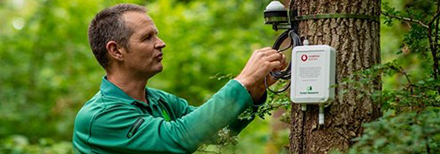UK’s Department for Environment, Food and Rural Affairs (Defra) is involved in the project with telecoms company Vodafone and forestry research specialist Forest Research. It involves using sensors attached to trees and connected through Vodafone’s narrowband-IoT (NB-IoT) network to collect data on factors such as tree growth, temperature, humidity and soil moisture. Forest Research will run analytics on the data to assess the impacts of environmental change on the forests. Source: Timberbiz
The three-month trial has begun in Forestry England’s Alice Holt Forest in Surrey and Harwood Forest in Northumberland. It is said to be the first of its kind in the UK.
The sensors, provided by Vodafone, are attached to several trees within different areas of the two forests, and data is constantly gathered and transmitted back to a web portal accessible by Defra and Forest Research.
NB-IoT operates within a very narrow radio band frequency enabling wider coverage and deeper penetration than traditional networks. Vodafone said this makes it suitable for use across large areas, underground or within buildings.
“Trees are a unique natural resource that play a crucial role in combating the biodiversity and climate crises we face,” Malcolm McKee, chief technology officer at Defra said.
“This exciting partnership uses newly emerging IoT technologies to improve our understanding of the impacts of environmental change on our nation’s forests, which will help inform our policy making. The new technology provides better quality data and importantly, allows us to monitor places that current technologies cannot reach.
“We are always looking for ways to explore how using innovative new technologies can improve our data gathering. This initial focus is on the monitoring of forests, but the technologies will be applicable to monitoring ‘anything’ in the environment.”
According to Matthew Wilkinson, research scientist at Forest Research this innovative collaborative project has the potential to transform the way they are able to collect and analyse data, and to reduce the need for frequent site visits, especially at remote rural locations.






